Louis I, Landgrave of Hesse
Last updatedYou can help expand this article with text translated from the corresponding article in German. (October 2012)Click [show] for important translation instructions.
|
Louis I | |
|---|---|
| Landgrave of Hesse | |
 | |
| Born | 6 February 1402 Spangenberg |
| Died | 17 January 1458 (aged 55) |
| Noble family | House of Hesse |
| Spouse(s) | Anna of Saxony |
| Issue | Louis II, Landgrave of Lower Hesse Henry III, Landgrave of Upper Hesse Hermann IV, Archbishop of Cologne Elisabeth Friedrich |
| Father | Hermann II, Landgrave of Hesse |
| Mother | Margaret of Hohenzollern-Nuremberg |
Louis I of Hesse (German : Ludwig) (6 February 1402 - 17 January 1458), called "the Peaceful", was Landgrave of Lower Hesse (Hesse) from 1413 to 1458.
He was born at Spangenberg, the son of Hermann II, Landgrave of Hesse, and Margaret, the daughter of Frederick V of Nuremberg. He married Anna (5 June 1420 - 17 September 1462) daughter of Frederick I, Elector of Saxony on 13 September 1436. Their children were:
- Louis II (7 September 1438 - 8 November 1471)
- Henry III (15 October 1440 - 13 January 1483)
- Hermann IV, Archbishop of Cologne (1450 - 19 October 1508)
- Elisabeth (14 December 1453 - 22 April 1489), married John III, Count of Nassau-Weilburg
- Friedrich (1458- 1 June 1463)
After 1425 a conflict with the Electorate of Mainz over claims to power in Hesse broke out into open conflict and Archbishop Conrad III of Mainz suffered a decisive defeat at Fulda in 1427.
Ancestry
External links
- Ludwig I. v. Hessen Allgemeine Deutsche Biographie. Band 52, Duncker & Humblot, Leipzig 1906, p. 115.
Related Research Articles
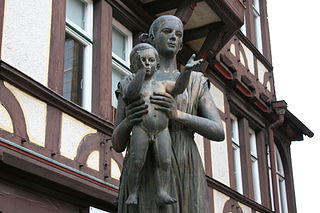
Henry I of Hesse "the Child" was the first Landgrave of Hesse. He was the son of Henry II, Duke of Brabant and Sophie of Thuringia.

Otto I of Hesse was Landgrave of Hesse from 1308 until his death.

Louis I, Grand Duke of Hesse was Landgrave of Hesse-Darmstadt and later the first Grand Duke of Hesse and by Rhine.

Charles Louis, Hereditary Prince of Baden was heir apparent of the Margraviate of Baden.

Louis IX of Hesse-Darmstadt was the reigning Landgrave of Hesse-Darmstadt from 1768 to 1790.
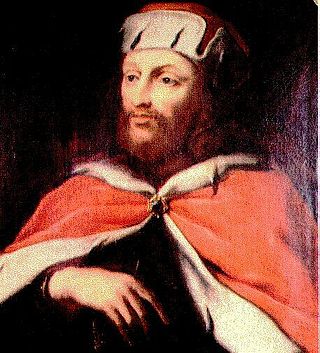
Otto I, called the Redhead, was Duke of Bavaria from 1180 until his death. He was also called Otto VI as Count Palatine of Bavaria from 1156 to 1180. He was the first Bavarian ruler from the House of Wittelsbach, a dynasty which reigned until the abdication of King Ludwig III of Bavaria in the German Revolution of 1918.

Georg Donatus, Hereditary Grand Duke of Hesse was the first child of Ernest Louis, Grand Duke of Hesse, and his second wife, Princess Eleonore of Solms-Hohensolms-Lich. He was a nephew of Empress Alexandra and Emperor Nicholas II of Russia.

Louis V of Hesse-Darmstadt was the Landgrave of Hesse-Darmstadt from 1596 to 1626.

Louis II of Hesse, called Louis the Frank, was the Landgrave of Lower Hesse from 1458 - 1471.

Hermann II of Hesse was Landgrave of Hesse from 1376 to 1413.
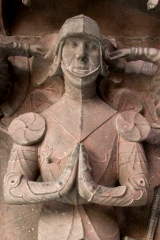
Henry III, Landgrave of Upper Hesse, called "the Rich" was the second son of Louis I of Hesse and his wife Anna of Saxony.
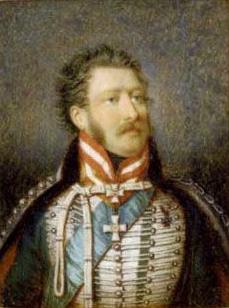
Frederick VI reigned as Landgrave of Hesse-Homburg from 1820 until his death in 1829.
Henry III, Duke of Brunswick-Lüneburg, of the House of Welf, was a Duke of Brunswick-Lüneburg ruling the ducal Principality of Grubenhagen between 1427 and 1464.
The Duchy of Thuringia was an eastern frontier march of the Merovingian kingdom of Austrasia, established about 631 by King Dagobert I after his troops had been defeated by the forces of the Slavic confederation of Samo at the Battle of Wogastisburg. It was recreated in the Carolingian Empire and its dukes were appointed by the king until it was absorbed by the Saxon dukes in 908. From about 1111/12 the territory was ruled by the Landgraves of Thuringia as Princes of the Holy Roman Empire. When Frederick IV, the last independent ruler of Thuringia died in 1440, the territory passed to his nephew, the saxon elector Frederick II.

Hermann IV of Hesse was the Archbishop-Elector of Cologne from 1480 to 1508 and the Prince-Bishop of Paderborn from 1498 to 1508.
Anna of Saxony was a princess of Saxony and by marriage landgravine of Hesse.
Henry VII of Waldeck was Count of Waldeck from 1397 until his death, after which he acted several times as bailiff for the Electorate of Mainz in Upper and Lower Hesse.
Louis of Meissen was a German nobleman from the House of Wettin. He was Bishop of Halberstadt and later Bishop of Bamberg, then Archbishop of Mainz and finally Archbishop of Magdeburg.
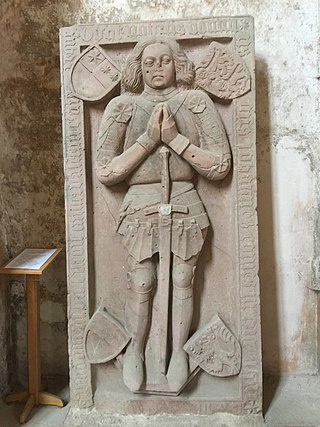
John II, Count of Ziegenhain was the second son of Count Gottfried VIII of Ziegenhain and his wife Agnes of Brunswick. He was the last reigning Count of Ziegenhain and Nidda. He probably owed His nickname the Strong to his obesity, although he is said to have possessed an extraordinary muscle strength as a young man. His younger brother Otto was Archbishop of Trier from 1419 until his death in 1430.
The Mainz-Hessian War of 1427 was the final military conflict in the two-century long dispute between the Archdiocese of Mainz and Landgrave of Hesse over supremacy of the Hesse region. The decisive victories of Landgrave Ludwig I over the Mainzian military leader Gottfried von Leiningen near Fritzlar and over Archbishop Konrad von Dhaun near Fulda spelled the end of Mainz's ambitions in the Hesse region. The Peace of Frankfurt, signed on December 8, 1427, decisively ended both the war and the long-standing power struggle between Hesse and Mainz.
Text is available under the CC BY-SA 4.0 license; additional terms may apply.
Images, videos and audio are available under their respective licenses.